Table of Contents
Instagram strategy: It turns out that having a big followership doesn’t guarantee that brands on Instagram will be well-followed. You may be thinking … isn’t that the same thing?
Though they sound the same, there’s a big difference – and the distinctions run deep. So deep that it may be be affecting the Instagram performances of established brands and, with Instagram at the head of social selling, online sales in general.
So, what’s the difference between having followers and being well-followed, aside from semantics? The easy answer is Instagram Engagement Rate. For us, a brand can’t be well-followed if their followers aren’t engaging with the content that they post.
Engagement Rates have been measured since the platform’s creation back in 2010, but interpretation hasn’t always been straight forward. Generally, we figure if you have a large number of followers then that should encapsulate how well your brand is performing. When, in fact, it could be the opposite.

Let’s say we have an Instagram user – Carla. On Instagram she follows, what we’ll call, an Established Brand, Hugo Boss, and an Emerging Brand, Sézane. Both are fashion brands – the first founded back in 1924 and the second in 2013.
Her Instagram profile may affirm Hugo Boss with a hit of the follow button, as she knows it to be a prominent brand. But she is excited to see that Sézane, a smaller and much newer brand, is using Instagram as a way to reach her, as if they were just another user of the platform. She likes and comments on Sézane’s engaging posts, uses their hashtag, and may even buy a dress directly from their Instagram because – treat yourself, Carla.
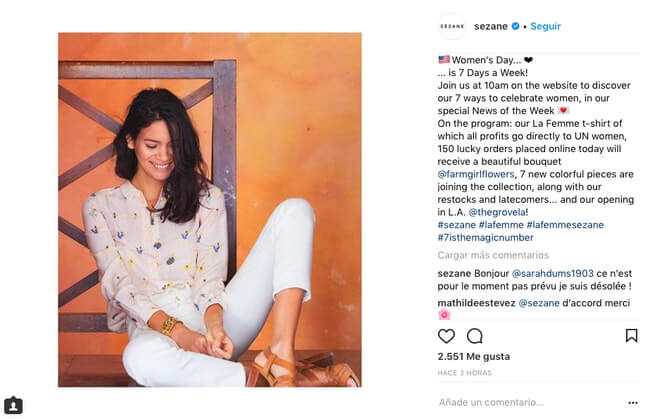
One can argue that this is entirely dependent on the Instagram strategy of both brands. To that I say, duh. But, after running some data on our internal analytics tools, we’ve noticed the trend that a lot of Established Brands on Instagram, founded well-before social media, have high numbers of followers but low scores in terms of engagement rate. And brands that have emerged within the dawning of social media and Instagram, engage more.
For this study, we’ve taken 20 brands on Instagram from a database of 500 luxury Fashion/Accessory brands selected based on what we call a Visual Marketing Index (VMI) scores – the top 10 highest and bottom 10 lowest scoring brands.
The VMI score shows how well brands are performing on Instagram, encompassing numerous metrics from a brand’s Instagram activity to give an overall performance score. The data for this analysis was gathered from the Instagram API prior to its deprecation in April 2018, which has since made a study of this nature impossible.
The math is complex but the important point to note is that the tool uses a benchmark model for each metric. This gives us a unique point for each brand, which measures performance independent of their followership size. In other words, we can use VMI score to compare how brands are doing on Instagram side by side, regardless of their size.
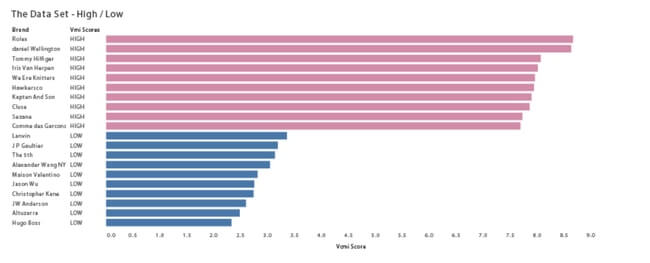
The selection happens to be a mix of Established Brands, those that predate social media, and Emerging Brands, those that have grown up or were conceived alongside it.
But this first graph doesn’t quite tell the whole story. So, next we’ll take a zoom in on the ‘Daily Engagement Rate’, or the number of likes per day that a brand receives on all of their posted media, for the top 10 brands.

Immediately, the group is very clearly divided. When ranked by their Daily Engagement Rate, we see a separation between the brands that predate social media (Before SM: Rolex/Tommy Hilfiger/Comme des Garcons), and those that grew up with it (Post SM: in this case the remaining group were all founded after 2007). In short, we see that the majority of the Emerging Brands on Instagram are getting Daily Engagement Rates that are more than 4x that achieved by the Established Brands.
Rolex, a leading watch brand and household name, was founded in 1905. This is the same year that Einstein proposed the theory of relativity. With a marketing strategy spanning over a century, Instagram engagement may not be high on their list. But should it be?
Most Established Brands never needed to grow their image through Instagram. Sales were already being generated by loyal disciples of the brand. With the social integration of Instagram, why would anything need to change?
Established Brands acquire followers due to recognition that precedes Instagram, as opposed to gaining followers because of strong content or Instagram strategy. As a result, their role on the network is typically more passive. Sometimes so passive that they don’t even feel the need to follow another account.

Since they never really needed to work for their followership, they don’t feel like they need to work to maintain it either. Fair enough, right? But, what goes around comes around.
As their followers remain unmaintained, perhaps these same followers also become more interested in shopping directly via Instagram – a social shopping trend that is becoming increasingly attractive to retailers and customers. If big brands on Instagram disregard the importance of engaging with their large followerships, will they lose out on a huge market for potential sales?
Social media complacency worked for well-known brands when these platforms were just used for cultivating brand image, something that they already had and would spread with traditional, mostly static, media. But as social content integration through User Generated Content (UGC) and influencers becomes more seamless, Established Brands may consider engaging with their followers – rather than solely relying on previous recognition to ensure they appear successful within this social space.
Ready to take your engagement to the next level with UGC? Book a demo with Flowbox now!
On the whole, Instagram provides a very affordable channel for Emerging Brands to promote themselves. And, because of their conception within a social media world, their style may even lend itself to the platform. Hence, they tend to perform much better within this space.
Up-and-coming fashion brands used to invest big on famous models and popular photographers to garner attention to new lines or just their existence as a brand. Anything to get the mainstream fashion press to turn heads in their direction.
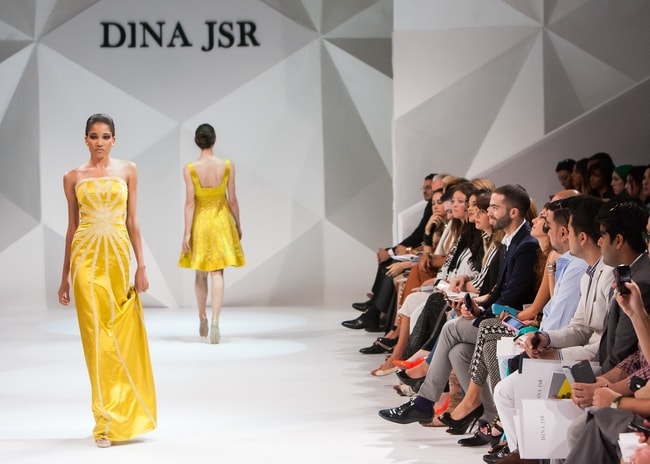
These days, however, the same up-and-coming fashion brands are spreading their investment across a range of Influencers, who are based primarily on Instagram. This direct touch point not only resonates with Instagram users, it’s also affordable. Influencers with more than 1 million followers can charge up to $10,000 for a single post, but this is nothing compared to pursuing the mainstream fashion press.
The highest scoring brand in our Daily Engagement Rate graph, Hawkers Co, spent the Summer of 2017 enhancing brand awareness with 13 Instagram influencers. Maybe that’s why they made it out on top?
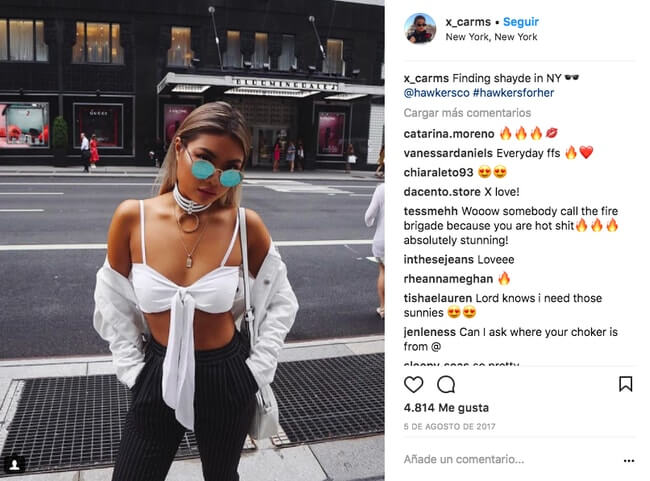
These highly followed Influencers – in terms of both numbers and engagement – have a huge impact on brand recognition. It’s something that brands who have not joined Instagram (an estimated 25% of US Businesses) simply cannot ignore anymore.
So, what was the deal before Instagram? Now that we have a way for the everyman brand to make their way to the top, it’s hard to remember how different the marketing process was pre-social media.
You know magazines? I’m sure you’ve seen them before – they’re like a book, only for fashion (and books are those things where they print words on paper). We all know that magazines have dominated the mainstream fashion media and, in the past, this was mostly through a few major publications.
Elle was famously known to ‘not so much reflect fashion as decree it.’ And this sentiment basically defined the role of the fashion press, pre-social media. Recognition was granted to the brands who could get themselves in front of Vogue or Harper’s Bazaar, or even the smaller, younger publications like InStyle or Nylon. For up-and-coming brands, there was word of mouth or maybe getting the influencers of the time into your garments.
But now that brands can reach customers without the mainstream media, will fashion press maintain the same influence?
Let’s return to our brands, this time bringing back the 10 lowest scoring brands and opening up to the full 20. Our next graph separates the fashion brands into 2 groups, categorized as YES or NO, with their distinguishing factors as follows…
YES: The brands that develop a couture range, receive mainstream press, are common household names.
NO: The brands that don’t receive mainstream press, and instead use Instagram strategy focused marketing.
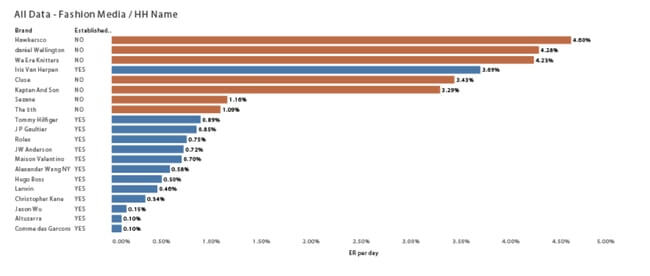
Again, we see the brands clearly separate – with only the exception of Iris Van Herpen. Those with mainstream ‘established’ recognition (YES) fall to the bottom, meaning a lower Engagement Rate per day, compared to those without the mainstream recognition (NO), freely rise to the top.
So what does this mean for the up-and-coming brands of this generation? This data demonstrates that emerging brands appear to be focusing on Instagram strategy as a means to grow their business.
Before, everyone relied on traditional advertising or direct recognition via the mainstream fashion press; it was the only way to get eyes on your product. And, in this sense, the fashion press used to act as a reputation barrier, filtering everything that was produced and having a massive impact on a brand’s success.
But now, Emerging Brands on Instagram or other social media platforms can completely circumnavigate the mainstream press and thus their way to customers. This change has rocked the fashion world into a more democratic arena in terms of who can become successful and for what reasons. Everyone has the opportunity to share/like/comment/judge without the prior filter of someone else’s opinion.
Of course, it’s not a perfect system. Money always talks, and that’s no different for Instagram strategy. But it certainly provides smaller brands a stepping-stone into the public eye and a platform to grow their business if they aren’t quite reaching for the big leagues just yet.
So, Instagram is clearly disrupting the status quo of fashion marketing. Never has it been easier for a customer to buy something they see in a post on their phone, and it’s only improving. Based on this evidence, what is the long term effect?
Fashion used to be dominated by a relatively small group of publications. And now it’s becoming less hierarchical because, at the end of the day, fashion is a business. If a brand can build themselves a profitable product with International recognition via a social channel, this is a success.
Customers have always had the opinion that counts, but it wasn’t until social media gave weight to the common voice, that they could really start using it. Something that was not possible until this past decade.
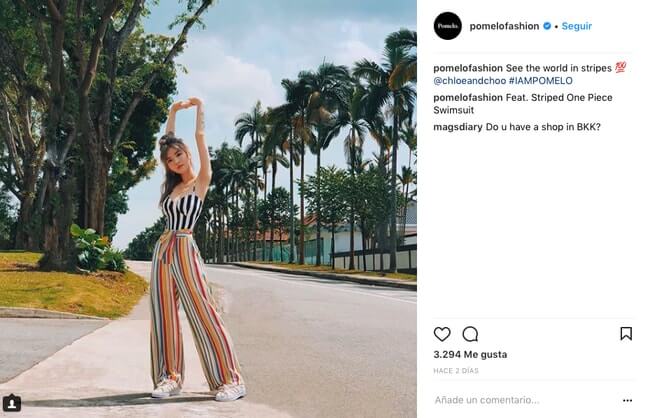
Not to mention that social media doesn’t just make it easier for brands to reach customers, but part of the beauty is that people get to ‘discover’ brands. The channel has created a space for a member of the public to be the one to ‘find’ the next up-and-coming brand with the coolest Instagram that you’ve just got to see.
Though mainstream fashion press will always reign supreme over mainstream style, its role and influence will have to change. And, like our Established brands, they can either decide to embrace the power of social media or remain complacent within it.
From this data, it appears that older brands and those with mainstream media recognition tend to perform worse with their Instagram strategy. Meanwhile, smaller brands on Instagram are able to take advantage, completely focusing their Instagram strategy on this space. And, as they gain a following, perhaps they also start to gain the attention of the mainstream press.
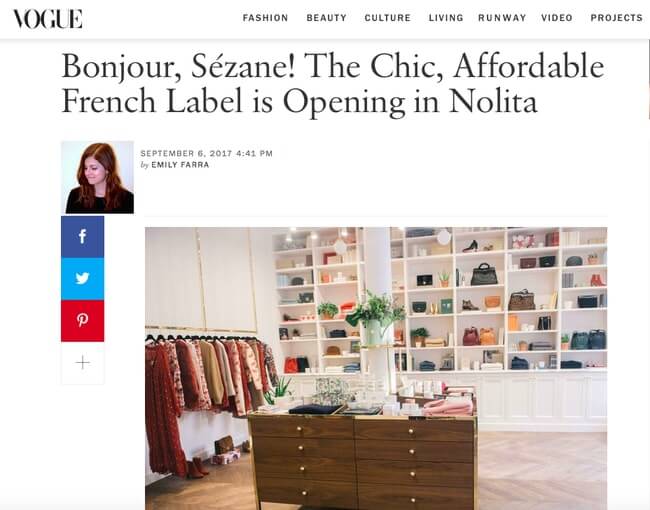
This new model of brand establishment opens up the opportunity. The general public are no longer unbreachable, but they exist right there, waiting to fall in love with the next best products and designs that pop up on their phone.
I’ll leave you with a parting question: is a brand going to come around and turn social media recognition on its head by becoming a household name via Instagram?
Could Hawkers be the RayBan of the future?
Let me know what you think about Instagram strategy in the comments below!
Looking for more Instagram tips? Head to our complete guide to Instagram Marketing, where you’ll find everything you need to know about promoting your products on this crucial platform.